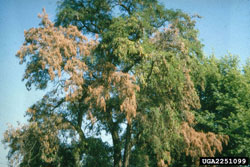What is verticillium wilt?
A rapid wilting of catalpa trees is presumably the result of a disease called Verticillium wilt. This can be confirmed by culturing. Relatively cool temperatures in the summer are ideal for development of this disease.
The Verticillium fungus persists in soil and infects a number of different trees through the roots including catalpa, ash, maple, redbud and sumac. Once inside the  fungus colonizes and plugs the vascular system resulting in leaf wilting and in some cases branch or tree mortality. In some, but not all trees a green to black streaking of the vascular system develops.
fungus colonizes and plugs the vascular system resulting in leaf wilting and in some cases branch or tree mortality. In some, but not all trees a green to black streaking of the vascular system develops.
What does verticillium wilt affect?
The disease may affect only a portion of the crown during the growing season, only to develop again the following spring in another portion of the tree. In other cases symptoms will not reappear.
Symptoms of Verticillium wilt can develop throughout the growing season, but are more common in early to mid summer. The fungus is inhibited by hot weather and can be very difficult to culture from symptomatic trees late in the season.
What should I do to a tree with this disease?
Wilted, dead branches should be removed from partially damaged trees. Be careful not to remove branches if they have releafed the same summer. Avoid wounding the roots or root collars of susceptible trees.
Presently, there are no satisfactory chemical controls for Verticillium wilt.



